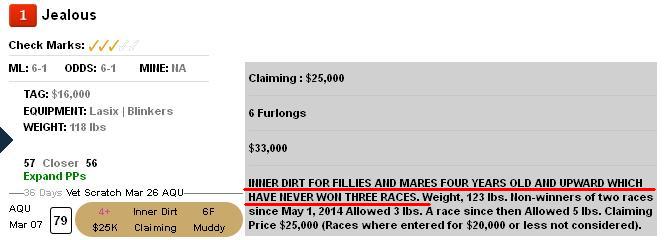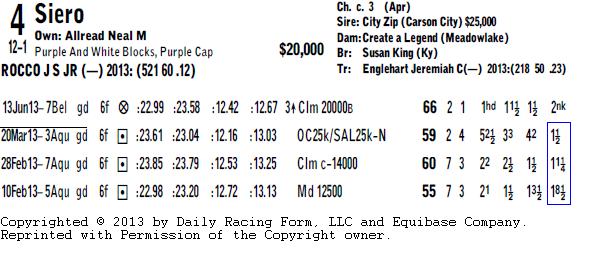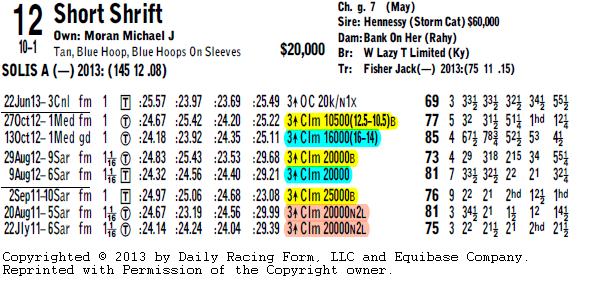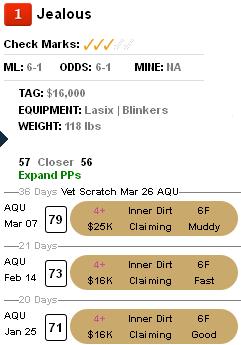Conditional Claiming Races: Require a Closer Look
In a prior article we introduced Claiming races. Click here for a review of that article. The type of races described in that article are open to any horse where the owner is willing to offer the horse for the claiming price of the race. But, there are other types of Claiming races where a horse can be entered only if they meet certain “conditions.” It is these type of races that we will focus on in this article. We’ll start with the simple, and work our way up to the more complex.
Example #1
We’ll begin by showing an example of the race conditions for a race run at Kentucky Downs on September 18, 2013.
The conditions of this race clearly state that ONLY horses who “Have Never Won Two Races” are allowed to enter. The shorthand description of this “N2L” appears in the race condition. This stands for “Non-winner of two races in their lifetime.” This along with the Claiming Price (Clm 12500 N2L) will appear in the future Past Performances (PPs) for all horses who ran in this race. We will provide a sample of what PPs look like further down in this article.
Example #2
The next example shows the race conditions for a race run at Saratoga on July 20, 2013.
In addition to the “Have Never Won Two Races” for this race is the addition of “Or Three Year Olds.” In the prior example at Kentucky Downs, 3yr old horses were allowed to enter … BUT, only if they had never won two or more races. In the race at Saratoga, 3yr old horses can enter regardless of how many races they have won. For example, the 3yr old horse listed below was entered in the race at Saratoga, despite having already won 3 times.
Example #3
Our third example expands the conditions of a race even further, and was run at Saratoga on July 19, 2013.
For this race, in addition to the number of wins condition (Never Won Three Races) and the age condition (all 3yr olds allowed) … is an added condition for horses that have not won a turf race since January 19, 2013. This means if a horse has NOT won a race on the turf since January 19, he can enter this race no matter how many races he has won in his lifetime. This opens the door to more starters, and potentially makes the field more competitive.
Why is that useful information? Because, when you are looking back at races run previously by a horse, and trying to evaluate the class of a horse, knowing who he/she ran against is half the battle. Competing in a field of horses that has conditions like the July 19 race is generally going to be more challenging than having run in a race with a simple N3L condition.
When looking back at the PPs for a horse, how do you know which type of claiming race they competed in? Let’s look at the PPs for the winner of the July 19 race at Saratoga.
We’ve highlighted the different types of Claiming races in matching colors. Conditional races with simple “Never Won Two Races conditions are in Pink. Races with additional conditions like the ones shown earlier are in Yellow. And, finally straight Claiming races without any conditions (other than claiming price) are in turquoise.
One footnote to this last example, Short Shrift won this race at odds of 14-1 … and he was able to run in this race despite having won four races in his career up to this point, because he met the last condition of not having won a race on the turf since January 19th.
All things being equal (mainly claiming price), the more restrictive the race conditions, the easier the competition. The more open the conditions, including ones for age and not having won a race since a certain date, the tougher the race will generally be.
When comparing straight claiming races (without conditions) to conditional claiming races, here is an analogy with professional football. Having “conditional” games would be like having a flexible schedule in the second half of the season, where some teams were restricted to play games against opponents that won only two games or less in the first half of the season. Obviously this would make the quality of their competition much easier, and their chances for winning much greater.
FOOTNOTE: TimeformUS PPs
For people who use TimeformUS, be careful when looking at PPs that include claiming races. At first glance, you do not know if the race was a straight claiming race without any conditions, or a conditional claiming race as described in this article.
In the example on the left, you can see the horse (Jealous) has been in three claiming races. The claiming prices ($25k, $16k, $16k) are clearly shown, but you cannot tell if there were conditions in each race.
However, if you click on the brown race oval for the most recent race (March 7), a pop up display will provide you with the details of the race, including any conditions. We’ve underlined them in the example below.

For what it’s worth to TFUS management, utilizing a descriptive acronym, like “Clm $25kN2L” within the oval would save people the time of having to click on each race to read the detailed race conditions.







2 comments on “Conditional Claiming Races: Require a Closer Look”